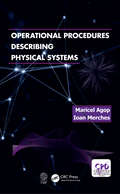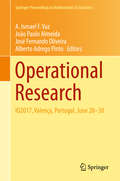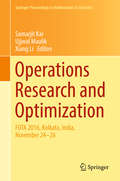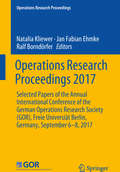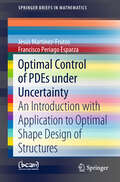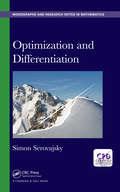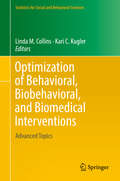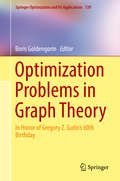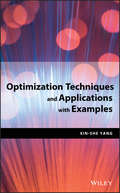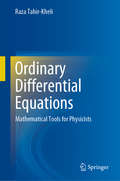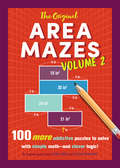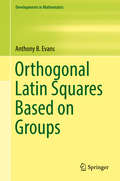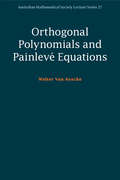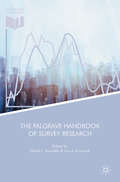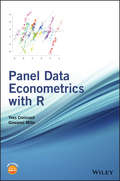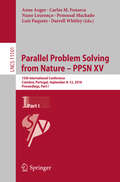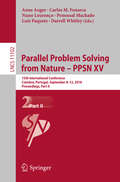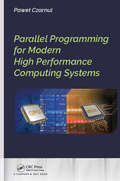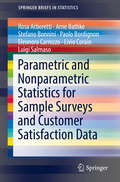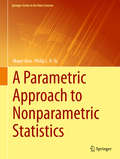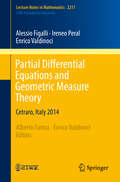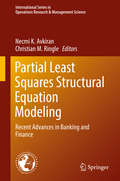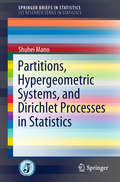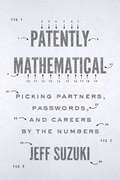- Table View
- List View
Operational Procedures Describing Physical Systems
by Marciel Agop Ioan MerchesThe authors examine topics in modern physics and offer a unitary and original treatment of the fundamental problems of the dynamics of physical systems, as well as a description of the nuclear matter within a framework of general relativity. They show that some physical phenomena studied at two different resolution scales (e.g. microscale, cosmological scale), apparently with no connection between them, become compatible by means of the operational procedures, acting either as some ”hidden” symmetries, or harmonic-type mappings. The book is addressed to the students, researchers and university/high school teachers working in the fields of mathematics, physics, and chemistry.
Operational Research
by João Paulo Almeida José Fernando Oliveira Alberto Adrego Pinto A. Ismael VazThis proceedings book presents selected contributions from the XVIII Congress of APDIO (the Portuguese Association of Operational Research) held in Valença on June 28–30, 2017. Prepared by leading Portuguese and international researchers in the field of operations research, it covers a wide range of complex real-world applications of operations research methods using recent theoretical techniques, in order to narrow the gap between academic research and practical applications. Of particular interest are the applications of, nonlinear and mixed-integer programming, data envelopment analysis, clustering techniques, hybrid heuristics, supply chain management, and lot sizing and job scheduling problems. In most chapters, the problems, methods and methodologies described are complemented by supporting figures, tables and algorithms.The XVIII Congress of APDIO marked the 18th installment of the regular biannual meetings of APDIO – the Portuguese Association of Operational Research. The meetings bring together researchers, scholars and practitioners, as well as MSc and PhD students, working in the field of operations research to present and discuss their latest works. The main theme of the latest meeting was Operational Research Pro Bono. Given the breadth of topics covered, the book offers a valuable resource for all researchers, students and practitioners interested in the latest trends in this field.
Operations Research and Optimization: Fota 2016, Kolkata, India, November 24-26 (Springer Proceedings In Mathematics And Statistics Series #225)
by Samarjit Kar Ujjwal Maulik Xiang LiThis book discusses recent developments in the vast domain of optimization. Featuring papers presented at the 1st International Conference on Frontiers in Optimization: Theory and Applications (FOTA 2016), held at the Heritage Institute of Technology, Kolkata, on 24–26 December 2016, it opens new avenues of research in all topics related to optimization, such as linear and nonlinear optimization; combinatorial-, stochastic-, dynamic-, fuzzy-, and uncertain optimization; optimal control theory; as well as multi-objective, evolutionary and convex optimization and their applications in intelligent information and technology, systems science, knowledge management, information and communication, supply chain and inventory control, scheduling, networks, transportation and logistics and finance. The book is a valuable resource for researchers, scientists and engineers from both academia and industry.
Operations Research Proceedings 2017: Selected Papers Of The Annual International Conference Of The German Operations Research Society (gor), Freie Universiät Berlin, Germany, September 6-8 2017 (Operations Research Proceedings Ser.)
by Ralf Borndörfer Jan Fabian Ehmke Natalia KliewerThis book gathers a selection of peer-reviewed papers presented at the International Conference on Operations Research (OR 2017), which was held at Freie Universität Berlin, Germany on September 6-8, 2017. More than 800 scientists, practitioners and students from mathematics, computer science, business/economics and related fields attended the conference and presented more than 500 papers in parallel topic streams, as well as special award sessions. The main theme of the conference and its proceedings was "Decision Analytics for the Digital Economy."
Optimal Control of PDEs under Uncertainty: An Introduction with Application to Optimal Shape Design of Structures (SpringerBriefs in Mathematics)
by Jesús Martínez-Frutos Francisco Periago EsparzaThis book provides a direct and comprehensive introduction to theoretical and numerical concepts in the emerging field of optimal control of partial differential equations (PDEs) under uncertainty. The main objective of the book is to offer graduate students and researchers a smooth transition from optimal control of deterministic PDEs to optimal control of random PDEs. Coverage includes uncertainty modelling in control problems, variational formulation of PDEs with random inputs, robust and risk-averse formulations of optimal control problems, existence theory and numerical resolution methods. The exposition focusses on the entire path, starting from uncertainty modelling and ending in the practical implementation of numerical schemes for the numerical approximation of the considered problems. To this end, a selected number of illustrative examples are analysed in detail throughout the book. Computer codes, written in MatLab, are provided for all these examples. This book is adressed to graduate students and researches in Engineering, Physics and Mathematics who are interested in optimal control and optimal design for random partial differential equations.
Optimization and Differentiation (Chapman & Hall/CRC Monographs and Research Notes in Mathematics)
by Simon SerovajskyOptimization and Differentiation is an introduction to the application of optimization control theory to systems described by nonlinear partial differential equations. As well as offering a useful reference work for researchers in these fields, it is also suitable for graduate students of optimal control theory.
Optimization of Behavioral, Biobehavioral, and Biomedical Interventions: Advanced Topics (Statistics for Social and Behavioral Sciences)
by Linda M. Collins Kari C. KuglerBehavioral, biobehavioral, and biomedical interventions are programs with the objective of improving and maintaining human health and well-being, broadly defined, in individuals, families, schools, organizations, or communities. These interventions may be aimed at, for example, preventing or treating disease, promoting physical and mental health, preventing violence, or improving academic achievement. This book provides additional information on a principled empirical framework for developing interventions that are more effective, efficient, economical, and scalable. This framework is introduced in the monograph, "Optimization of Behavioral, Biobehavioral, and Biomedical Interventions: The Multiphase Optimization Strategy (MOST)" by Linda M. Collins (Springer, 2018). The present book is focused on advanced topics related to MOST. The chapters, all written by experts, are devoted to topics ranging from experimental design and data analysis to development of a conceptual model and implementation of a complex experiment in the field. Intervention scientists who are preparing to apply MOST will find this book an important reference and guide for their research. Fields to which this work pertains include public health (medicine, nursing, health economics, implementation sciences), behavioral sciences (psychology, criminal justice), statistics, and education.
Optimization Problems in Graph Theory: In Honor of Gregory Z. Gutin's 60th Birthday (Springer Optimization and Its Applications #139)
by Boris GoldengorinThis book presents open optimization problems in graph theory and networks. Each chapter reflects developments in theory and applications based on Gregory Gutin’s fundamental contributions to advanced methods and techniques in combinatorial optimization. Researchers, students, and engineers in computer science, big data, applied mathematics, operations research, algorithm design, artificial intelligence, software engineering, data analysis, industrial and systems engineering will benefit from the state-of-the-art results presented in modern graph theory and its applications to the design of efficient algorithms for optimization problems. Topics covered in this work include:· Algorithmic aspects of problems with disjoint cycles in graphs· Graphs where maximal cliques and stable sets intersect· The maximum independent set problem with special classes· A general technique for heuristic algorithms for optimization problems · The network design problem with cut constraints· Algorithms for computing the frustration index of a signed graph· A heuristic approach for studying the patrol problem on a graph· Minimum possible sum and product of the proper connection number· Structural and algorithmic results on branchings in digraphs · Improved upper bounds for Korkel--Ghosh benchmark SPLP instances
Optimization Techniques and Applications with Examples
by Xin-She YangA guide to modern optimization applications and techniques in newly emerging areas spanning optimization, data science, machine intelligence, engineering, and computer sciences Optimization Techniques and Applications with Examples introduces the fundamentals of all the commonly used techniques in optimization that encompass the broadness and diversity of the methods (traditional and new) and algorithms. <p><p> The author—a noted expert in the field—covers a wide range of topics including mathematical foundations, optimization formulation, optimality conditions, algorithmic complexity, linear programming, convex optimization, and integer programming. In addition, the book discusses artificial neural network, clustering and classifications, constraint-handling, queueing theory, support vector machine and multi-objective optimization, evolutionary computation, nature-inspired algorithms and many other topics. <p> Designed as a practical resource, all topics are explained in detail with step-by-step examples to show how each method works. The book’s exercises test the acquired knowledge that can be potentially applied to real problem solving. By taking an informal approach to the subject, the author helps readers to rapidly acquire the basic knowledge in optimization, operational research, and applied data mining.
Ordinary Differential Equations: Mathematical Tools For Physicists
by Raza Tahir-KheliThis textbook describes rules and procedures for the use of Differential Operators (DO) in Ordinary Differential Equations (ODE). The book provides a detailed theoretical and numerical description of ODE. It presents a large variety of ODE and the chosen groups are used to solve a host of physical problems. Solving these problems is of interest primarily to students of science, such as physics, engineering, biology and chemistry. <P><P> Scientists are greatly assisted by using the DO obeying several simple algebraic rules. The book describes these rules and, to help the reader, the vocabulary and the definitions used throughout the text are provided. A thorough description of the relatively straightforward methodology for solving ODE is given. <P><P>The book provides solutions to a large number of associated problems. ODE that are integrable, or those that have one of the two variables missing in any explicit form are also treated with solved problems. The physics and applicable mathematics are explained and many associated problems are analyzed and solved in detail. Numerical solutions are analyzed and the level of exactness obtained under various approximations is discussed in detail.
The Original Area Mazes, Volume 2: 100 More Addictive Puzzles to Solve with Simple Math—and Clever Logic! (Original Area Mazes)
by Naoki Inaba Ryoichi MurakamiThe rules are simple . . . The math is easy . . . The puzzles get harder and harder! Hooked on area mazes? YOU’RE IN LUCK! Volume Two delivers 100 more puzzles. Your quest is to navigate a network of rectangles to find a missing value. Just remember: Area = length × widthUse spatial reasoning to find helpful relationshipsWhole numbers are all you need. You can always get the answer without using fractions! Originally invented for gifted students, area mazes have taken all of Japan by storm. Are you a sudoku fanatic? Do you play brain games to stay sharp? Did you love geometry . . . or would you like to finally show it who’s boss? Try area mazes—they could be just what you’re craving!
Orthogonal Latin Squares Based on Groups (Developments in Mathematics #57)
by Anthony B. EvansThis monograph presents a unified exposition of latin squares and mutually orthogonal sets of latin squares based on groups. Its focus is on orthomorphisms and complete mappings of finite groups, while also offering a complete proof of the Hall–Paige conjecture. The use of latin squares in constructions of nets, affine planes, projective planes, and transversal designs also motivates this inquiry. The text begins by introducing fundamental concepts, like the tests for determining whether a latin square is based on a group, as well as orthomorphisms and complete mappings. From there, it describes the existence problem for complete mappings of groups, building up to the proof of the Hall–Paige conjecture. The third part presents a comprehensive study of orthomorphism graphs of groups, while the last part provides a discussion of Cartesian projective planes, related combinatorial structures, and a list of open problems. Expanding the author’s 1992 monograph, Orthomorphism Graphs of Groups, this book is an essential reference tool for mathematics researchers or graduate students tackling latin square problems in combinatorics. Its presentation draws on a basic understanding of finite group theory, finite field theory, linear algebra, and elementary number theory—more advanced theories are introduced in the text as needed.
Orthogonal Polynomials and Painlevé Equations
by Walter Van AsscheThere are a number of intriguing connections between Painlevé equations and orthogonal polynomials, and this book is one of the first to provide an introduction to these. Researchers in integrable systems and non-linear equations will find the many explicit examples where Painlevé equations appear in mathematical analysis very useful. Those interested in the asymptotic behavior of orthogonal polynomials will also find the description of Painlevé transcendants and their use for local analysis near certain critical points helpful to their work. Rational solutions and special function solutions of Painlevé equations are worked out in detail, with a survey of recent results and an outline of their close relationship with orthogonal polynomials. Exercises throughout the book help the reader to get to grips with the material. The author is a leading authority on orthogonal polynomials, giving this work a unique perspective on Painlevé equations.
The Palgrave Handbook of Survey Research
by David L. Vannette Jon A. KrosnickThis handbook is a comprehensive reference guide for researchers, funding agencies and organizations engaged in survey research. Drawing on research from a world-class team of experts, this collection addresses the challenges facing survey-based data collection today as well as the potential opportunities presented by new approaches to survey research, including in the development of policy. It examines innovations in survey methodology and how survey scholars and practitioners should think about survey data in the context of the explosion of new digital sources of data. The Handbook is divided into four key sections: the challenges faced in conventional survey research; opportunities to expand data collection; methods of linking survey data with external sources; and, improving research transparency and data dissemination, with a focus on data curation, evaluating the usability of survey project websites, and the credibility of survey-based social science. Chapter 23 of this book is open access under a CC BY 4. 0 license at link. springer. com.
Panel Data Econometrics with R
by Giovanni Millo Yves CroissantPanel Data Econometrics with R provides a tutorial for using R in the field of panel data econometrics. Illustrated throughout with examples in econometrics, political science, agriculture and epidemiology, this book presents classic methodology and applications as well as more advanced topics and recent developments in this field including error component models, spatial panels and dynamic models. They have developed the software programming in R and host replicable material on the book’s accompanying website.
Parallel Problem Solving from Nature – PPSN XV: 15th International Conference, Coimbra, Portugal, September 8–12, 2018, Proceedings, Part I (Lecture Notes in Computer Science #11101)
by Anne Auger Carlos M. Fonseca Nuno Lourenço Penousal Machado Luís Paquete Darrell WhitleyThis two-volume set LNCS 11101 and 11102 constitutes the refereed proceedings of the 15th International Conference on Parallel Problem Solving from Nature, PPSN 2018, held in Coimbra, Portugal, in September 2018. The 79 revised full papers were carefully reviewed and selected from 205 submissions. The papers cover a wide range of topics in natural computing including evolutionary computation, artificial neural networks, artificial life, swarm intelligence, artificial immune systems, self-organizing systems, emergent behavior, molecular computing, evolutionary robotics, evolvable hardware, parallel implementations and applications to real-world problems. The papers are organized in the following topical sections: numerical optimization; combinatorial optimization; genetic programming; multi-objective optimization; parallel and distributed frameworks; runtime analysis and approximation results; fitness landscape modeling and analysis; algorithm configuration, selection, and benchmarking; machine learning and evolutionary algorithms; and applications. Also included are the descriptions of 23 tutorials and 6 workshops which took place in the framework of PPSN XV.
Parallel Problem Solving from Nature – PPSN XV: 15th International Conference, Coimbra, Portugal, September 8–12, 2018, Proceedings, Part II (Lecture Notes in Computer Science #11102)
by Anne Auger Carlos M. Fonseca Nuno Lourenço Penousal Machado Luís Paquete Darrell WhitleyThis two-volume set LNCS 11101 and 11102 constitutes the refereed proceedings of the 15th International Conference on Parallel Problem Solving from Nature, PPSN 2018, held in Coimbra, Portugal, in September 2018. The 79 revised full papers were carefully reviewed and selected from 205 submissions. The papers cover a wide range of topics in natural computing including evolutionary computation, artificial neural networks, artificial life, swarm intelligence, artificial immune systems, self-organizing systems, emergent behavior, molecular computing, evolutionary robotics, evolvable hardware, parallel implementations and applications to real-world problems. The papers are organized in the following topical sections: numerical optimization; combinatorial optimization; genetic programming; multi-objective optimization; parallel and distributed frameworks; runtime analysis and approximation results; fitness landscape modeling and analysis; algorithm configuration, selection, and benchmarking; machine learning and evolutionary algorithms; and applications. Also included are the descriptions of 23 tutorials and 6 workshops which took place in the framework of PPSN XV.
Parallel Programming for Modern High Performance Computing Systems
by Pawel CzarnulIn view of the growing presence and popularity of multicore and manycore processors, accelerators, and coprocessors, as well as clusters using such computing devices, the development of efficient parallel applications has become a key challenge to be able to exploit the performance of such systems. This book covers the scope of parallel programming for modern high performance computing systems. It first discusses selected and popular state-of-the-art computing devices and systems available today, These include multicore CPUs, manycore (co)processors, such as Intel Xeon Phi, accelerators, such as GPUs, and clusters, as well as programming models supported on these platforms. It next introduces parallelization through important programming paradigms, such as master-slave, geometric Single Program Multiple Data (SPMD) and divide-and-conquer. The practical and useful elements of the most popular and important APIs for programming parallel HPC systems are discussed, including MPI, OpenMP, Pthreads, CUDA, OpenCL, and OpenACC. It also demonstrates, through selected code listings, how selected APIs can be used to implement important programming paradigms. Furthermore, it shows how the codes can be compiled and executed in a Linux environment. The book also presents hybrid codes that integrate selected APIs for potentially multi-level parallelization and utilization of heterogeneous resources, and it shows how to use modern elements of these APIs. Selected optimization techniques are also included, such as overlapping communication and computations implemented using various APIs. Features: Discusses the popular and currently available computing devices and cluster systems Includes typical paradigms used in parallel programs Explores popular APIs for programming parallel applications Provides code templates that can be used for implementation of paradigms Provides hybrid code examples allowing multi-level parallelization Covers the optimization of parallel programs
Parametric and Nonparametric Statistics for Sample Surveys and Customer Satisfaction Data (SpringerBriefs in Statistics)
by Rosa Arboretti Arne Bathke Stefano Bonnini Paolo Bordignon Eleonora Carrozzo Livio Corain Luigi SalmasoThis book deals with problems related to the evaluation of customer satisfaction in very different contexts and ways. Often satisfaction about a product or service is investigated through suitable surveys which try to capture the satisfaction about several partial aspects which characterize the perceived quality of that product or service. This book presents a series of statistical techniques adopted to analyze data from real situations where customer satisfaction surveys were performed.The aim is to give a simple guide of the variety of analysis that can be performed when analyzing data from sample surveys: starting from latent variable models to heterogeneity in satisfaction and also introducing some testing methods for comparing different customers. The book also discusses the construction of composite indicators including different benchmarks of satisfaction. Finally, some rank-based procedures for analyzing survey data are also shown.
A Parametric Approach to Nonparametric Statistics (Springer Series in the Data Sciences)
by Philip L. H. Yu Mayer AlvoThis book demonstrates that nonparametric statistics can be taught from a parametric point of view. As a result, one can exploit various parametric tools such as the use of the likelihood function, penalized likelihood and score functions to not only derive well-known tests but to also go beyond and make use of Bayesian methods to analyze ranking data. The book bridges the gap between parametric and nonparametric statistics and presents the best practices of the former while enjoying the robustness properties of the latter. This book can be used in a graduate course in nonparametrics, with parts being accessible to senior undergraduates. In addition, the book will be of wide interest to statisticians and researchers in applied fields.
Partial Differential Equations and Geometric Measure Theory: Cetraro, Italy 2014 (Lecture Notes in Mathematics #2211)
by Enrico Valdinoci Enrico ValdinociAlberto Farina Ireneo Peral Alessio FigalliThis book collects together lectures by some of the leaders in the field of partial differential equations and geometric measure theory. It features a wide variety of research topics in which a crucial role is played by the interaction of fine analytic techniques and deep geometric observations, combining the intuitive and geometric aspects of mathematics with analytical ideas and variational methods. The problems addressed are challenging and complex, and often require the use of several refined techniques to overcome the major difficulties encountered. The lectures, given during the course "Partial Differential Equations and Geometric Measure Theory'' in Cetraro, June 2–7, 2014, should help to encourage further research in the area. The enthusiasm of the speakers and the participants of this CIME course is reflected in the text.
Partial Differential Equations in Fluid Mechanics (London Mathematical Society Lecture Note Series #452)
by Charles L. Fefferman James C. Robinson José L. RodrigoThe Euler and Navier–Stokes equations are the fundamental mathematical models of fluid mechanics, and their study remains central in the modern theory of partial differential equations. This volume of articles, derived from the workshop 'PDEs in Fluid Mechanics' held at the University of Warwick in 2016, serves to consolidate, survey and further advance research in this area. It contains reviews of recent progress and classical results, as well as cutting-edge research articles. Topics include Onsager's conjecture for energy conservation in the Euler equations, weak-strong uniqueness in fluid models and several chapters address the Navier–Stokes equations directly; in particular, a retelling of Leray's formative 1934 paper in modern mathematical language. The book also covers more general PDE methods with applications in fluid mechanics and beyond. This collection will serve as a helpful overview of current research for graduate students new to the area and for more established researchers.
Partial Least Squares Structural Equation Modeling: Recent Advances in Banking and Finance (International Series in Operations Research & Management Science #267)
by Christian M. Ringle Necmi K. AvkiranThis book pulls together robust practices in Partial Least Squares Structural Equation Modeling (PLS-SEM) from other disciplines and shows how they can be used in the area of Banking and Finance. In terms of empirical analysis techniques, Banking and Finance is a conservative discipline. As such, this book will raise awareness of the potential of PLS-SEM for application in various contexts. PLS-SEM is a non-parametric approach designed to maximize explained variance in latent constructs. Latent constructs are directly unobservable phenomena such as customer service quality and managerial competence. Explained variance refers to the extent we can predict, say, customer service quality, by examining other theoretically related latent constructs such as conduct of staff and communication skills. Examples of latent constructs at the microeconomic level include customer service quality, managerial effectiveness, perception of market leadership, etc.; macroeconomic-level latent constructs would be found in contagion of systemic risk from one financial sector to another, herd behavior among fund managers, risk tolerance in financial markets, etc. Behavioral Finance is bound to provide a wealth of opportunities for applying PLS-SEM. The book is designed to expose robust processes in application of PLS-SEM, including use of various software packages and codes, including R. PLS-SEM is already a popular tool in marketing and management information systems used to explain latent constructs. Until now, PLS-SEM has not enjoyed a wide acceptance in Banking and Finance. Based on recent research developments, this book represents the first collection of PLS-SEM applications in Banking and Finance. This book will serve as a reference book for those researchers keen on adopting PLS-SEM to explain latent constructs in Banking and Finance.
Partitions, Hypergeometric Systems, and Dirichlet Processes in Statistics (SpringerBriefs in Statistics #0)
by Shuhei ManoThis book focuses on statistical inferences related to various combinatorial stochastic processes. Specifically, it discusses the intersection of three subjects that are generally studied independently of each other: partitions, hypergeometric systems, and Dirichlet processes. The Gibbs partition is a family of measures on integer partition, and several prior processes, such as the Dirichlet process, naturally appear in connection with infinite exchangeable Gibbs partitions. Examples include the distribution on a contingency table with fixed marginal sums and the conditional distribution of Gibbs partition given the length. The A-hypergeometric distribution is a class of discrete exponential families and appears as the conditional distribution of a multinomial sample from log-affine models. The normalizing constant is the A-hypergeometric polynomial, which is a solution of a system of linear differential equations of multiple variables determined by a matrix A, called A-hypergeometric system. The book presents inference methods based on the algebraic nature of the A-hypergeometric system, and introduces the holonomic gradient methods, which numerically solve holonomic systems without combinatorial enumeration, to compute the normalizing constant. Furher, it discusses Markov chain Monte Carlo and direct samplers from A-hypergeometric distribution, as well as the maximum likelihood estimation of the A-hypergeometric distribution of two-row matrix using properties of polytopes and information geometry. The topics discussed are simple problems, but the interdisciplinary approach of this book appeals to a wide audience with an interest in statistical inference on combinatorial stochastic processes, including statisticians who are developing statistical theories and methodologies, mathematicians wanting to discover applications of their theoretical results, and researchers working in various fields of data sciences.
Patently Mathematical: Picking Partners, Passwords, and Careers by the Numbers
by Jeff SuzukiUncovers the surprising ways math shapes our lives—from whom we date to what we learn.How do dating sites match compatible partners? What do cell phones and sea coasts have in common? And why do computer scientists keep ant colonies? Jeff Suzuki answers these questions and more in Patently Mathematical, which explores the mathematics behind some of the key inventions that have changed our world.In recent years, patents based on mathematics have been issued by the thousands—from search engines and image recognition technology to educational software and LEGO designs. Suzuki delves into the details of cutting-edge devices, programs, and products to show how even the simplest mathematical principles can be turned into patentable ideas worth billions of dollars. Readers will discover • whether secure credit cards are really secure• how improved data compression made streaming video services like Netflix a hit• the mathematics behind self-correcting golf balls• why Google is such an effective and popular search engine• how eHarmony and Match.com find the perfect partner for those seeking a mate• and much more!A gifted writer who combines quirky historical anecdotes with relatable, everyday examples, Suzuki makes math interesting for everyone who likes to ponder the world of numerical relationships. Praise for Jeff Suzuki's Constitutional Calculus"Presents an entertaining and insightful approach to the mathematics that underlies the American system of government. The book is neatly organized, breaking down the United States Constitution by article, section, and amendment. Within each piece, Suzuki reviews the mathematical principles that went into the underlying framework."—Mathematical Reviews"A breath of fresh air.... A reaffirmation that mathematics should be used more often to make general public policy."—MAA Reviews
